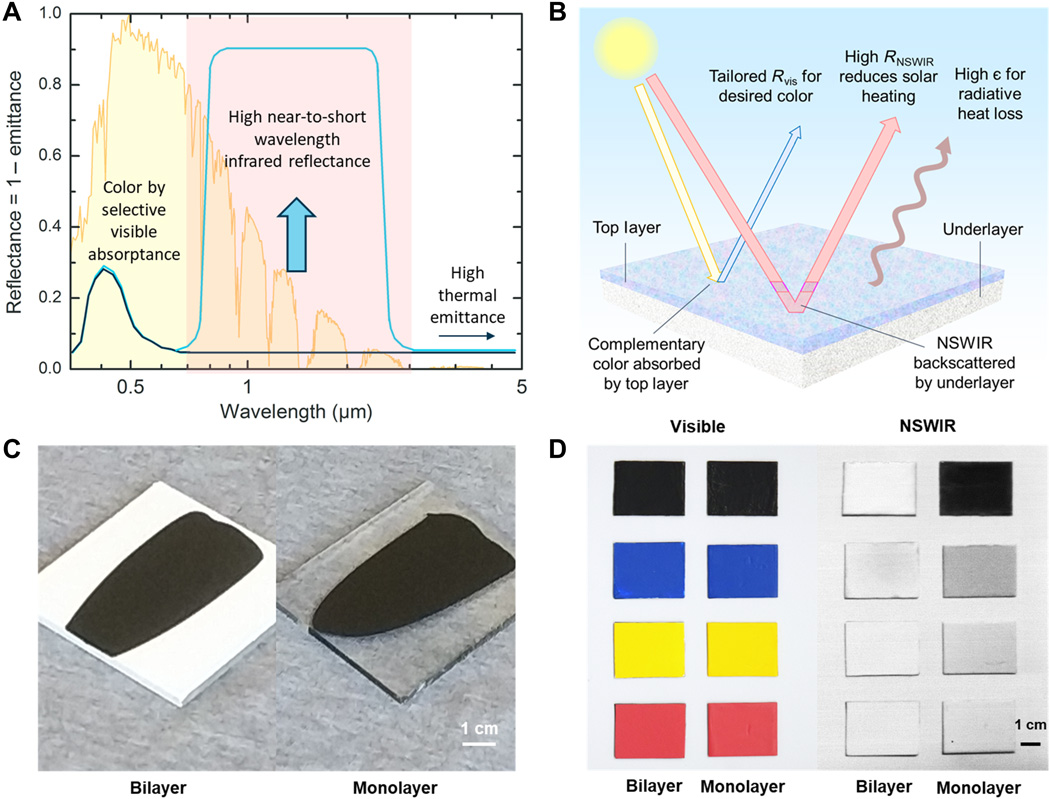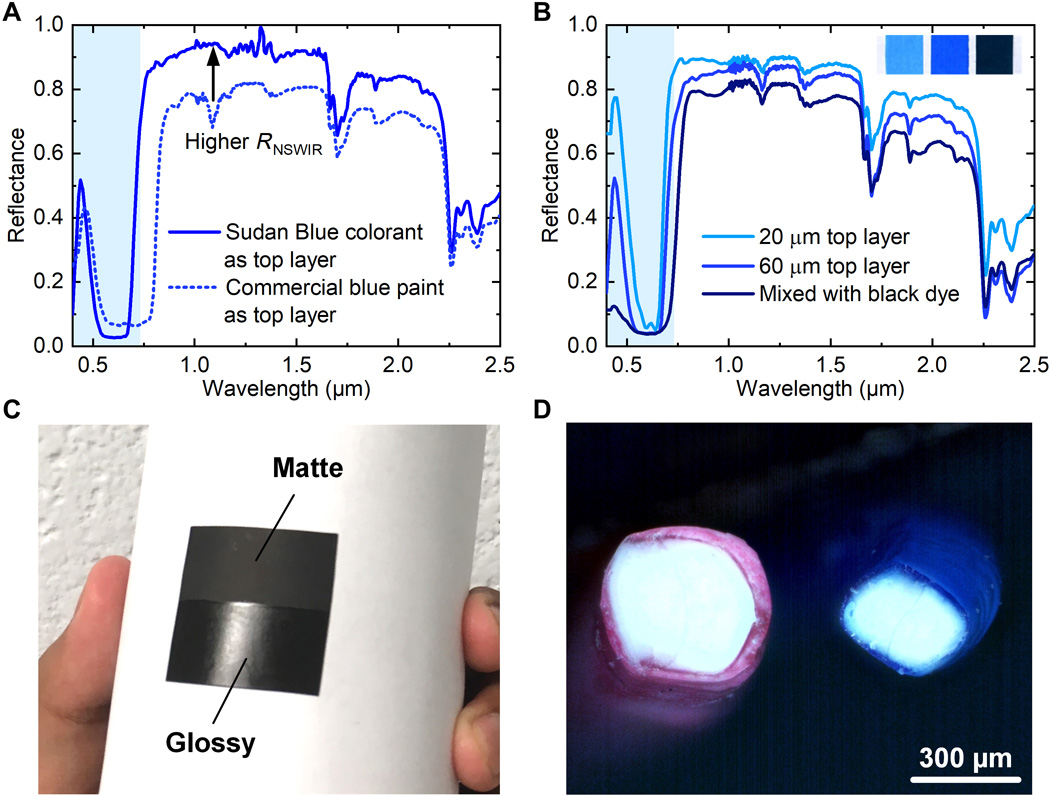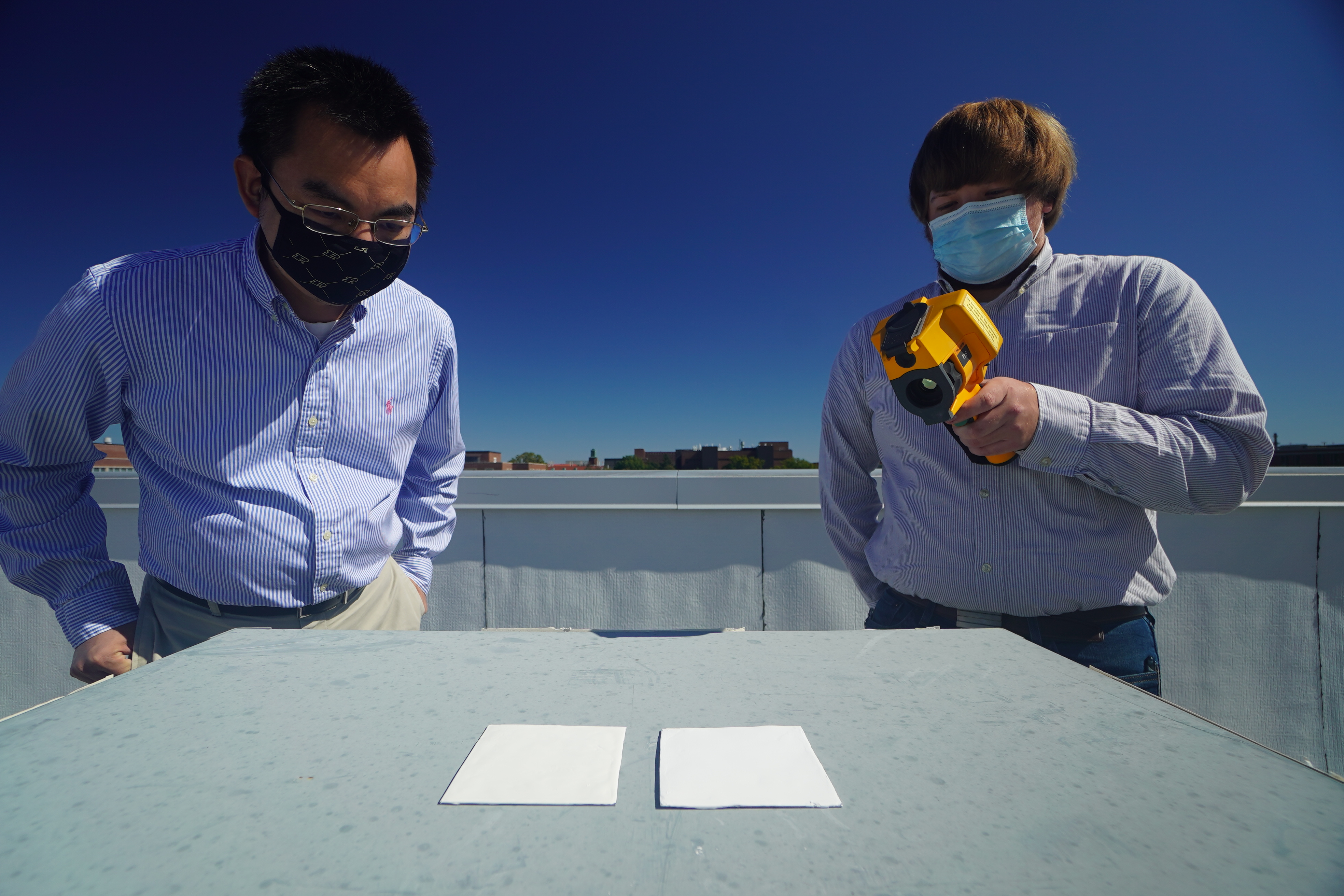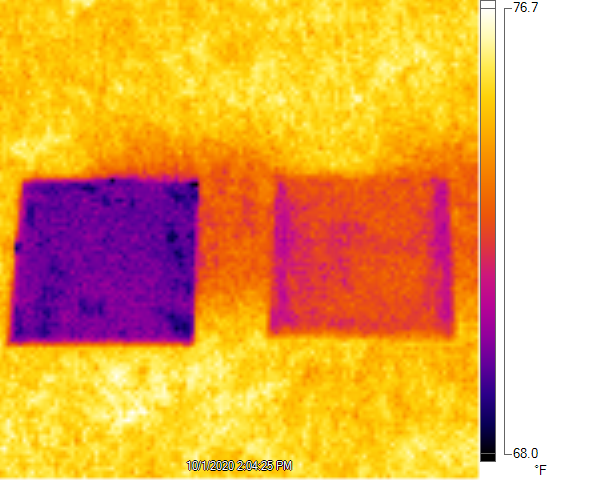Cool paint

|
|
Bilayer coloured radiative coolers (CRCs) for enhanced near-to-short wavelength infrared reflectance (NSWIR).
Photo credits: Photograph C - J.M., Columbia University; Photograph D - S.S., Columbia University. |
Contents |
[edit] Introduction
Paint is a liquid material that can be applied to surfaces to colour, protect and provide texture. In 2020, researchers announced the development of two types of innovative reflective paints that can also serve to cool surfaces and help to reduce energy consumption in buildings.
[edit] Coloured reflective coating
In April 2020, a group of scientists at New York’s Columbia University, under the guidance of Yuan Yang, introduced a bilayer, multicoloured infrared reflective paint. The top layer of this coating is made up of commercial, coloured paint while the bottom layer incorporates an infrared reflective polymer. Regardless of the colour selected for the top layer, the coating maintains its reflective properties.
Historically, paints containing titanium dioxide (TiO2) and colourants tend to absorb near-to-short wavelength infrared reflectance (NSWIR) wavelengths. This usually makes them hotter rather than cooler when exposed to sunlight. However, Yang’s top layer coating selectively absorbs visible wavelengths that are complementary to the desired colour but not others, while the underlayer maximises the distribution of any sunlight transmitted by the top layer.
Consequently, the two layers exhibit similar colours and visible reflectances (RVIS) to those of commercial monolayer paint - but with improved NSWIR. This results in a higher cooling performance and lower temperatures for the bilayers under sunlight.

|
|
Tuning the coloured top layer in the bilayer cooling paints.
Photo credits: Photograph C - J.M., Columbia University; Photograph D - C.-C.T., Columbia University. |
Test results demonstrated cooler temperatures even with black paint, which typically absorbs heat. In an article in New Scientist, Layal Liverpool writes, “painting an object with a black version of this new coating kept it about 16°C cooler than when an object painted with commercial black paint was exposed to the same amount of sunlight. In another test, the new paint coating was found to be able to maintain its colour despite being placed in an oven at 60°C for 30 days.”
[edit] Super white reflective coating
In October 2020, Xiulin Ruan and his colleagues at Indiana’s Purdue University introduced a new type of white paint with 95.5% solar reflectance. Most typical commercial heat rejecting paints reflect between 80%-90% of sunlight and cannot achieve temperatures below their surroundings. This new coating can reduce surface temperatures - without consuming any energy - below that of the surrounding air. It is able to accomplish this even when exposed to sunlight.
The researchers considered more than 100 different material combinations, narrowed them down to 10 and tested about 50 different formulations for each material. They selected a formulation made of calcium carbonate. This compound, used as the paint’s filler, allowed the formulation to behave essentially the same as commercial white paint but with greatly enhanced cooling properties.
These calcium carbonate fillers absorb almost no ultraviolet rays due to a so-called large “band gap,” a result of their atomic structure. They also have a high concentration of particles that are different sizes, allowing the paint to scatter a wider range of wavelengths.

|

|
| Purdue researchers Xiulin Ruan (left) and Joseph Peoples (right) use an infrared camera to compare the cooling performance of white paint samples on a rooftop. Credit: Purdue University; photo/Jared Pike. | An infrared camera image shows that white radiative cooling paint developed by Purdue University researchers (left, purple) can stay cooler in direct sunlight compared with commercial white paint. Credit: Purdue University; image/Joseph Peoples. |
The paint’s formulation is based on previous attempts to develop radiative cooling paint that could replace consumer dependence on air conditioning. According to the researchers’ cost estimates, this paint could both cut air conditioning expenses and be cheaper to produce than its commercial alternative.
The researchers are working on developing other paint colours that could have cooling benefits. The team filed an international patent application on this paint formulation through the Purdue Research Foundation Office of Technology Commercialization.
[edit] Related articles on Designing Buildings Wiki
- Albedo in the built environment.
- Cool roofs.
- Earthquake resistant building materials.
- Heat transfer in buildings.
- Paint.
- Paints and coatings.
- Thermal behaviour of architectural fabric structures.
[edit] External resources
- New Scientist, Infrared-reflecting paint can cool buildings even when it is black.
- Purdue University, This white paint could reduce the need for air conditioning by keeping surfaces cooler than surroundings.
- Science Advances, Colored and paintable bilayer coatings with high solar-infrared reflectance for efficient cooling.
- Science Direct, Full Daytime Sub-ambient Radiative Cooling in Commercial-like Paints with High Figure of Merit.
Featured articles and news
Government consultations for the summer of 2025
A year of Labour, past and present consultations on the environment, the built environment, training and tax.
CMA competitiveness probe of major housing developers
100 million affordable housing contributions committed with further consultation published.
Homes England supports Greencore Homes
42 new build affordable sustainable homes in Oxfordshire.
Zero carbon social housing: unlocking brownfield potential
Seven ZEDpod strategies for brownfield housing success.
CIOB report; a blueprint for SDGs and the built environment
Pairing the Sustainable Development Goals with projects.
Types, tests, standards and fires relating to external cladding
Brief descriptions with an extensive list of fires for review.
Latest Build UK Building Safety Regime explainer published
Key elements in one short, now updated document.
UKGBC launch the UK Climate Resilience Roadmap
First guidance of its kind on direct climate impacts for the built environment and how it can adapt.
CLC Health, Safety and Wellbeing Strategy 2025
Launched by the Minister for Industry to look at fatalities on site, improving mental health and other issues.
One of the most impressive Victorian architects. Book review.
Common Assessment Standard now with building safety
New CAS update now includes mandatory building safety questions.
RTPI leader to become new CIOB Chief Executive Officer
Dr Victoria Hills MRTPI, FICE to take over after Caroline Gumble’s departure.
Social and affordable housing, a long term plan for delivery
The “Delivering a Decade of Renewal for Social and Affordable Housing” strategy sets out future path.
A change to adoptive architecture
Effects of global weather warming on architectural detailing, material choice and human interaction.
The proposed publicly owned and backed subsidiary of Homes England, to facilitate new homes.
How big is the problem and what can we do to mitigate the effects?
Overheating guidance and tools for building designers
A number of cool guides to help with the heat.
The UK's Modern Industrial Strategy: A 10 year plan
Previous consultation criticism, current key elements and general support with some persisting reservations.
Building Safety Regulator reforms
New roles, new staff and a new fast track service pave the way for a single construction regulator.
























